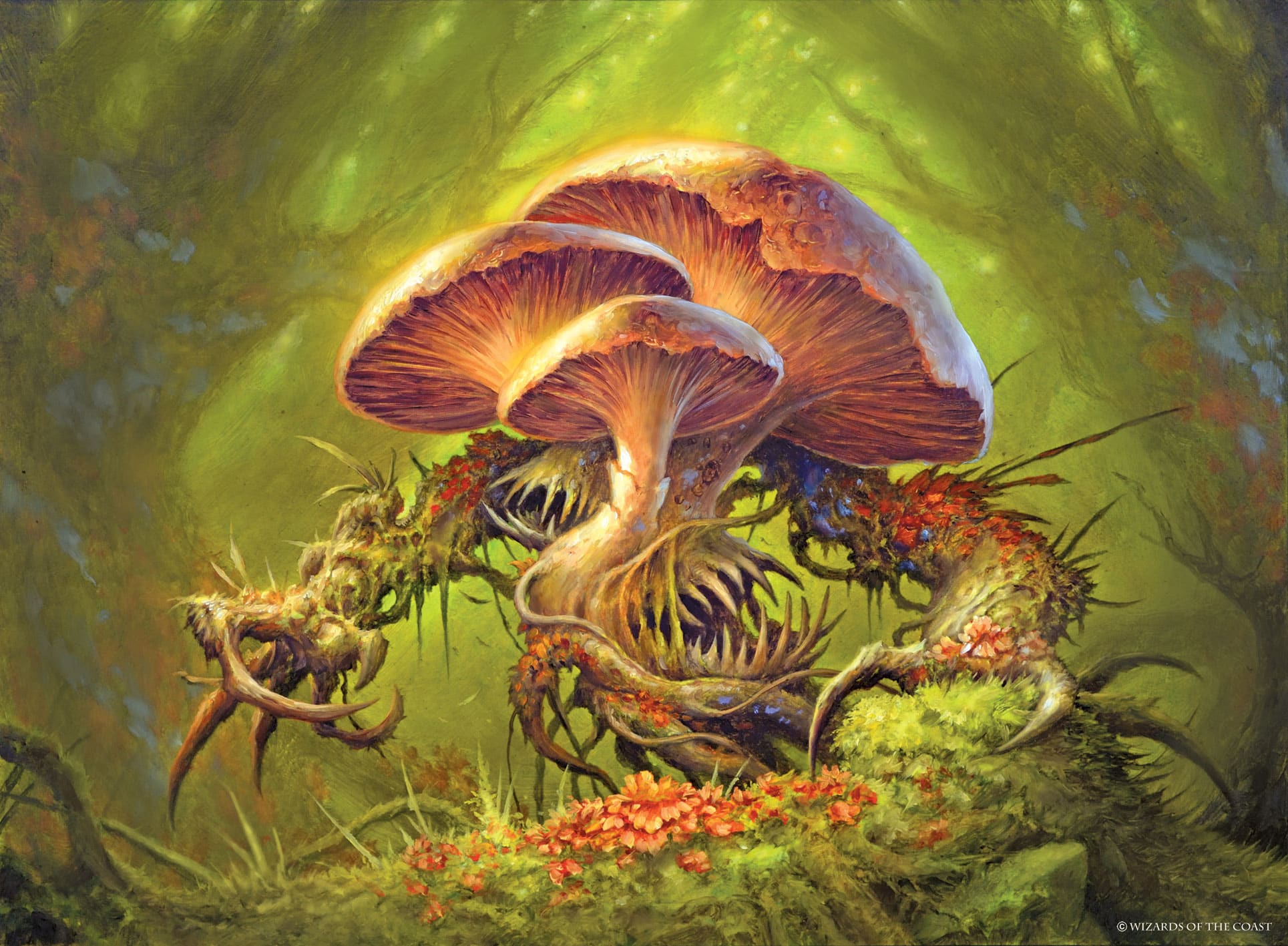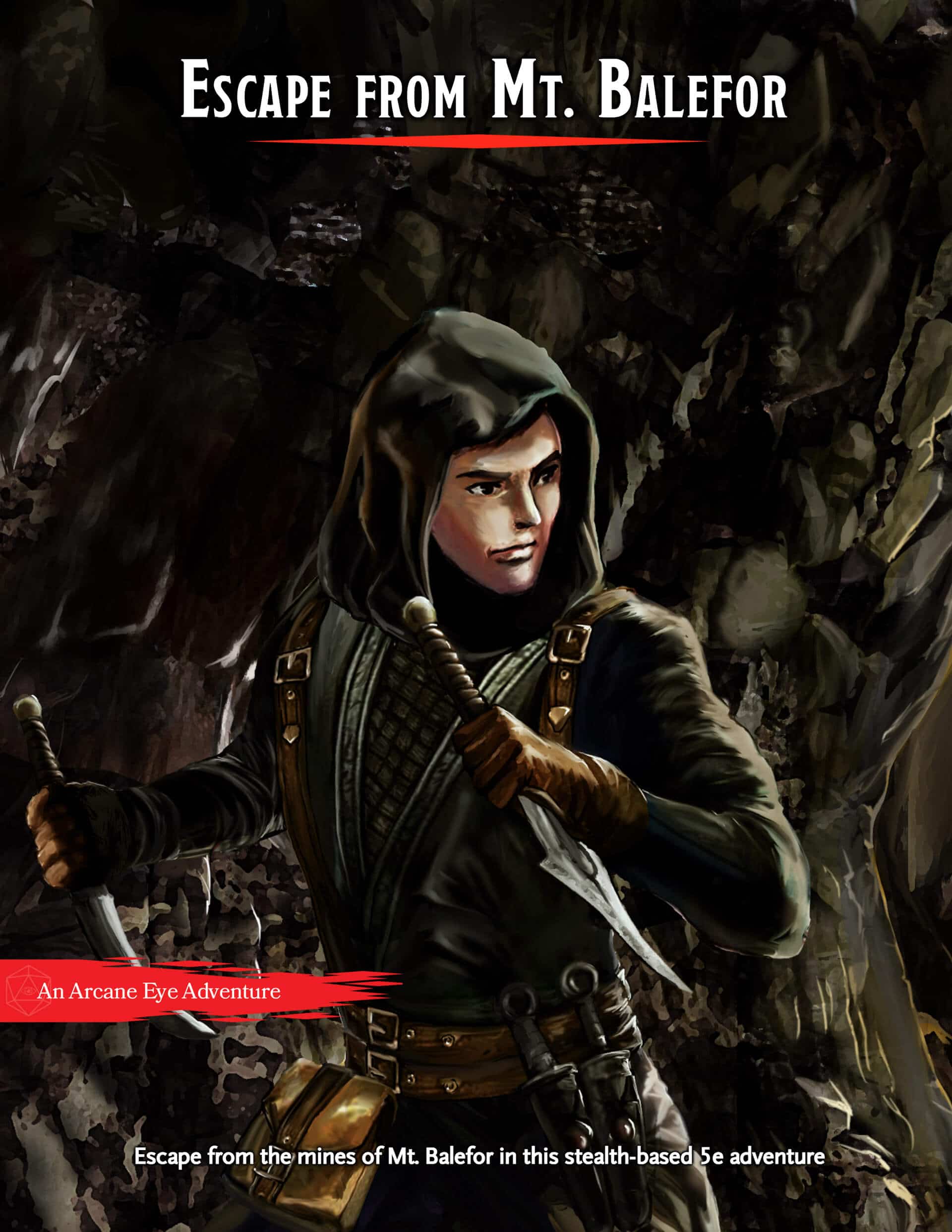Myconids: The Mushroom People of D&D
Published on March 8, 2024, Last modified on March 11th, 2024
Learn about myconid society, their abilities, and how you can play as a mushroom person in your D&D game!

Mark Winters - Wizards of the Coast - Sporecrown Thallid
Table of Contents
Myconid in D&D 5e
Myconids are the mushroom people of D&D. These sentient fungi live in tight-knit Underdark communities and are known for their peaceful societies. Let’s explore the lore behind myconids, how you can use them in your game, and how you can play as a mushroom person in D&D!
Myconid Overview
Physical Description
Myconids are giant fungus beings, varying in height from 2 feet (Tiny) to 12 feet (large Medium). While they are normally bipedal, with humanoid-like legs, arms, and eyes, they are considered the Plant creature type in D&D’s fifth edition. Their skin, which ranges through shades of purples, greens, reds, oranges, and grays, rises in patchy ripples across their body up to a crown-like shape on top of their head.
When immobile, these people can be mistaken as mushrooms, especially because the eyes on their caps blend in seamlessly when closed.
Society and Behavior
Like any mushroom, myconids prefer cool, dark, and damp environments. This leads them to establish their societies in the Underdark more often than not, though they do exist in subterranean dungeons and maybe even some overgrown swamps.
Myconoids live in a very structured society based on tight social groups known as circles. Circles can contain up to two dozen members and usually specialize in certain tasks, such as cultivation, exploration, or defense. Any single myconid society consists of a variety of circles, each responsible for performing their specialized task.
Characteristically non-violent and distrustful of outsiders due to past experiences, myconids value peaceful coexistence, offering shelter to those with no ill intentions. Their society revolves around a strict schedule of sleep, work, and a unique activity called ‘melding,’ which is central to their communal life.
Melding
Melding is a process in which multiple myconids connect via telepathic and hallucinogenic spores to share thoughts, emotions, and experiences. This process is vital for their communal lifestyle and is considered both a recreational activity and a form of social interaction. Melding can strengthen the bonds within a circle and across the myconid society, reinforcing their values of harmony and mutual support.
Leaders and the Sovereign
Each myconid circle is led by one or more circle leaders, who are responsible for the well-being and organization of their members. Above them is the Sovereign, a singular figure in each myconid community. The Sovereign oversees the entire society, coordinates between circles, and makes decisions on behalf of all myconids. This role is often seen as burdensome due to the high level of responsibility and isolation from normal communal activities.
Abilities
Myconids possess limited offensive capabilities, mainly using their fists in defense. Their primary strength lies in producing spores with various effects, ranging from communication and hallucination to creating new myconids or pacifying threats. Older myconids and sovereigns can use spores for more complex tasks like animating corpses or performing fungal alchemy for various purposes:
- Animating Spores: This ability allows myconids to animate dead bodies, turning them into spore servants. These servants serve the myconid community and can perform tasks or defend the myconids from threats. This process takes 24 hours, after which the corpse rises as a loyal servant for a duration of 1d4 + 1 weeks.
- Distress Spores: When a myconid suffers harm, it releases distress spores that can be sensed by other myconids within a large radius. This instant communication of distress helps them to quickly rally in defense or to offer aid, which goes along with their communal nature and mutual concern for the well-being of their kind.
- Hallucination Spores: Myconids can release spores causing intense hallucinations in creatures that fail a Constitution saving throw. This incapacitating effect renders the affected creature unable to act while experiencing vivid hallucinations, which can be used by myconids to deter aggression without causing permanent harm.
- Pacifying Spores: These spores are used to stun potential threats, rendering them incapable of action for a time. It’s a defensive mechanism that myconids use to avoid conflict, reflecting their preference for peaceful resolutions. The affected creature must pass a Constitution saving throw or be stunned, with the opportunity to break free from the effect at the end of each turn.
- Rapport Spores: This remarkable ability fosters telepathic communication within a 30-foot radius, allowing myconids and other intelligent creatures to share thoughts and language silently.
Playing as a Myconid

So, you want to play as mushroom people in D&D. While there aren’t any official rules for a myconid race in the fifth edition, a homebrew version is available below.
When playing a myconid character, consider how their unique biology and pacifistic culture influence their interactions with the world and party members. Myconids are curious, thoughtful, and often seek harmonious solutions to conflicts.
Homebrew Myconid Traits
Your myconid character has the following racial traits.
Ability Score Increase
Your Constitution score increases by 2, and your Wisdom score increases by 1.
Age
Myconids mature quickly, reaching adulthood by the age of 4. Due to their fungal nature, they can live up to 240 years if not destroyed by disease or violence.
Size
You are Tiny, Small, or Medium. You choose the size when you select this race.
Speed
Your walking speed is 25 feet.
Spore Abilities
You have inherited the iconic spore-based abilities of your myconid kin. You can cast spare the dying at will, symbolizing your connection to the cycle of life and death through spores. At 3rd level, you can cast lesser restoration once with this trait. You can cast it a number of times equal to your proficiency bonus, and you regain all expended uses when you finish a long rest. Wisdom is your spellcasting ability for these spells.
Sun Sickness
Direct sunlight is harmful to your fungal form. While in sunlight, you have disadvantage on attack rolls, as well as Wisdom (Perception) checks that rely on sight.
Communion of Spores
As a bonus action, you can release spores to establish telepathic communication with other creatures within 30 feet that can understand at least one language. This telepathic link lasts for 10 minutes. Once you use this trait, you can’t use it again until you finish a short or long rest.
Fungal Regeneration
You can regain hit points equal to your Constitution modifier (minimum of 1) at the start of your turn if you have at least 1 hit point and aren’t in sunlight. This trait does not activate on turns you take fire damage. You can use this trait a number of times equal to your proficiency bonus, and you regain all expended uses when you finish a long rest.
Languages
You can speak, read, and write Common and Undercommon.
Using Myconids in Your Game

As a Dungeon Master, you can use these peaceful, fungal beings to present unique challenges and introduce themes that provoke thought and moral inquiry.
Establish the Setting
The Underdark, with its pitch black, sprawling caverns and unique ecosystem, serves as the perfect backdrop for myconid encounters. These societies of fungal people can be a beacon of safety among the many dangers a party normally faces in the subterranean environment, and the vast fungal forests glowing with bioluminescent can certainly help draw your players towards them.
While myconids might be suspicious of the party, and they look like monsters for the party to fight, it’s important to establish them as peaceful. This could be done by providing the party with rapport spores so they can converse telepathically or by allowing them to witness the communal nature of the myconid people.
Using Myconids as Adventure Hooks
As evidenced in Baldur’s Gate 3’s trip to the Ebonlake Grotto, a myconid colony facing issues can be a staple of an Underdark adventure environment. While the myconid’s propensity to lend a haven to the party, combined with their pacifist nature, means that the most likely hook would be to have the party defend the colony in some capacity, there are some other ways you can include these mushroom people in your game:
- Territorial Disputes: In the aforementioned hit video game, players encounter a myconid society being harassed by a group of duergar nearby. The players can lend their aid to the myconid colony, which in turn offers benefits for re-establishing a safe environment.
- Mysterious Illness: A disease affects the myconid spores, threatening their melding process and societal cohesion. This mission is particularly applicable to a druid, especially one that follows the Circle of Spores.
- Violent Myconids: If you’ve already established that myconids are peaceful, it could be fun to turn the stereotype on its head and have a party stumble across a violent colony of myconids. They may have to investigate the reasons for the colony’s violence, as it goes against their typical nature.
If you want the myconids to be a challenge to overcome, it’s best to keep them for low-level adventuring parties. There are only three myconid stat blocks presented in the Monster Manual, with the highest being a CR 2:
- The CR 0 myconid sprout
- The CR 1/2 myconid adult
- The CR 2 myconid sovereign
You could also consider making other creatures “spore servants,” which is the process by which a myconid sovereign uses their reanimated spores to resurrect a corpse into a servant for the colony.
